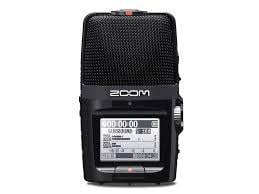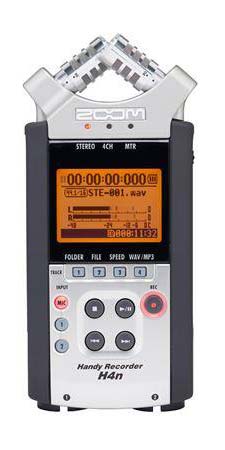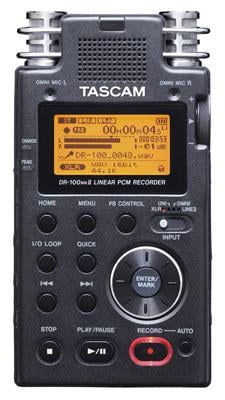Handheld Recorder Buyers Guide 2022
Introduction/Uses
by Headsnack
Portable recorders are the best way to capture your life. While your mobile device may record, it isn’t built for high-quality audio. Once you hear the realism of better-than-CD quality audio, you’ll never go back to using the voice memo feature on your phone again. Portable recorders do not have moving parts, therefore they are not only reliable, but they won’t generate unwanted noise like a tape recorder would. In addition, they can easily connect to a computer for quick file transfer. In this guide you’ll learn how to find the best voice recorder for you.
Here are a few ways in which portable digital recorders can be utilized:
Musicians: From beginners to professionals, everybody can benefit from hearing themselves recorded. Use a music recorder for practice or to get down song ideas. All file formats are compatible with computer recording software so you can easily transfer files to your favorite D.A.W. (Digital Audio Workstation) or audio editor.
Bands: Handhelds record in a variety of popular file formats, making it easy for bands to share their live shows or rehearsals with fans and friends. Portable field recorders can be used as a stereo room mic or to record a direct line out feed from any mixing console.
Producers: Handheld and portable recorders allow you the ability to record your own samples for later use in composition; they are also great devices for sound design or Foley.
Videographers: Add high-quality audio to your films and projects.
Professionals: Doctors, lawyers, teachers, writers, news reporters, etc. can easily capture thoughts, notes, or interviews using a digital voice recorder.
Students: Record lessons and lectures for later recall.
Houses of worship: Capture sermons or special events to share with members.
Everyday people: Record your children, loved ones, or sounds you hear while on vacation. Playing back a high-quality recording of environmental sounds can instantly transport you back to the moment.
Which recorder is right for you?
The following is designed to help you decide which features you should look for in a digital recorder.
Inputs: How many do you need? Most handhelds have two condenser microphones and record in stereo, whereas some have the ability to record up to six inputs at once.
Overdubbing: A useful feature for layering ideas. For example, record a rhythm guitar part and then on top of it add a lead riff or vocal verse.
External microphones: Do you need plug-in or phantom power? Look for an external mic input that also supplies power.
Connections: Most units have a 1/8th inch jack to directly record external sources. Using a standard 3.5mm (1/8th inch) to dual 1/4” or RCA, will allow you to get a direct feed off a mixing board or other stereo source (such as keyboard or stomp box). More professional models may include XLR, TRS (balanced 1/4 inch) or Neutrik combo jacks (both XLR & TRS). Headphone output is standard.
Effects: If the recorder has effects, you can polish your sound with reverb or compression. Some even allow you to use these effects while monitoring (listening as you record).
File Formats & Storage
Portable and handheld recorders have options for choosing file format. Typically it is either WAV or MP3. Some recorders can also record as BWF (Broadcast Wave Format). BWF time-stamps the audio so that you can later sync it with video.
Within each format you can also choose the sample rate and sometimes bit depth. The higher the sample rate, the better the quality. Sample rate represents how many snapshots of audio are taken in one second. For example, CD quality has a sample rate of 44.1kHz, or 44,100 samples per second and a bit depth of 16. Bit depth corresponds to the resolution of each sample taken; again the higher the better. Both the format and the quality within each format affect file size. The larger the file size, the better the quality, but also the more storage required.
 While some units have internal storage in the form of flash memory (files remain even after powering down, until you delete them), most rely on using readily available memory cards such as SD, SDHC, microSD, microSDHC, or Compact Flash. Depending on the model, they will usually support cards up to 128GB in size. A cd-quality stereo WAV file is approximately 10MB per minute. So for every one GB you can record approximately 100 minutes of audio. Conversely, the best quality MP3 (320kb/s) will yield slightly over seven hours per GB. In either case, having a large card will ensure it won’t fill up too quickly. Imagine how many tapes you would need if this were a tape recorder!
While some units have internal storage in the form of flash memory (files remain even after powering down, until you delete them), most rely on using readily available memory cards such as SD, SDHC, microSD, microSDHC, or Compact Flash. Depending on the model, they will usually support cards up to 128GB in size. A cd-quality stereo WAV file is approximately 10MB per minute. So for every one GB you can record approximately 100 minutes of audio. Conversely, the best quality MP3 (320kb/s) will yield slightly over seven hours per GB. In either case, having a large card will ensure it won’t fill up too quickly. Imagine how many tapes you would need if this were a tape recorder!
Field Recorders vs Handheld Recorders
While either style is truthfully portable, the differences lie in the size of the actual units as well as feature sets. Handheld recorders are designed to literally fit in the palm of your hand, whereas portable recorders have a larger footprint. Portable field recorders tend to be used by film makers, sound designers, and those in need of multiple external inputs and phantom power. They also tend to have more recording options such as onboard MS (Mid-Side, an advanced microphone technique) decoding, and advanced editing functions.
Microphone Configuration
Most handheld music recorders have two microphones to record in stereo. The placement of the microphones affects how sound is captured. The built in microphones on handheld recorders typically have one of two designs. Some advanced models offer swappable microphone capsules so you can change the pickup pattern depending on your application. Others have adjustable mics so that you can easily change the angle based on the source of sound.
 XY: With XY, the microphone heads are facing each other and form a 90 degree angle. The field of recording is narrower resulting in a tighter stereo image.
XY: With XY, the microphone heads are facing each other and form a 90 degree angle. The field of recording is narrower resulting in a tighter stereo image.
 AB: In this style of mic configuration, the recorder will pick up the sound of the room more than XY. This can add ambiance and depth to your recordings.
AB: In this style of mic configuration, the recorder will pick up the sound of the room more than XY. This can add ambiance and depth to your recordings.
MS (Mid-Side): Mid-Side is a recording technique used when both the direct sound and ambiance are important. One microphone capsule captures sound in front of it, whereas another mic capsule records sound from the left and right.
Other Features to Consider
The best voice recorders tend to have extensive feature sets that help you get the most out of both your recording and playback experience. These aren’t available in every model so be sure to check the feature set of each product page.
Battery power or rechargeable batteries: The majority of models use standard AA batteries but some are rechargeable. All can also function with a power supply. Sometimes the power supply is not included so be sure to purchase one if it’s optional.
Limiter: Setting your initial levels properly is crucial in achieving an optimal recording. However, there are times when levels spike and it is beyond your control. Many digital recorders offer a built in limiter which prevents your recording from clipping. This protects your recording from unwanted distortion.
Low-cut filter: Helps reduce unwanted handling and wind noise. Sometimes the frequency where the filter initiates is adjustable.
Wi-Fi: Some models allow for control via Wi-Fi. This is useful if you set up your device in one location but need to start recording from another.
Mounting: When using in conjunction with a camera, mounting threads can make set up a lot easier.
Speaker: Although all units have headphone jacks, some also have an external speaker for quickly listening back to your audio.
Variable speed playback: This feature allows you to speed up or slow down your recording. This is useful if you’re listening to dictation or trying to figure out a difficult solo.
Camera mount: If you’re using your recorder with a camera, having a threaded tripod mount socket comes in handy.
Markers: Some portables have the ability to add markers to the file while you’re recording. This makes dividing the recording up a lot easier. For example, if you record your band’s set, you can then separate each song played into separate files.
USB recorder: All of these devices, whether made to be a digital voice recorder, music recorder, or field recorder have the ability to transfer files to a computer via USB. USB cables are usually included when you purchase a digital recorder.
Accessories
When purchasing your music recorder be sure to have everything you might need.
Batteries: When external power is not an option, extra batteries come in handy for those extra long recording sessions.
Memory card: Having an extra memory card is always a good idea so that you always have plenty of storage space.
Windscreen: Help to reduce unwanted wind noise.
Mounting adapter: If your portable recorder has a threaded tripod mount, pick up a stand adapter to be able to use it with a standard mic stand.
Power supply: When recording where electricity is present, use the proper power supply. It saves money used on batteries.
Cables: If you want to record a line level signal from an instrument or mixing console, be sure to have the proper cables.
Microphone: This is a great idea if you’re going to be interviewing someone or using a field recorder.
GoPro accessories: If you’re buying a GoPro you’ll want to make sure you have everything to get you in the action. There are lots of different options such as mic stand adapters, underwater cases, and helmet mounts.
Portable VIdeo Recorders & GoPro
Video recorders are the best way to capture the action in high-definition. Some also have onboard microphones resulting in high-resolution audio. Most video recorders have wide-angle lenses so that you can record a large area at a time. In addition, they have the ability to vary the frames per second (FPS). The higher the FPS, the more detail captured during high action events.
These devices make it easy to record your live performance and then share them with your friends and fans. Whether the application is an indie film or made for YouTube, you can count on these devices to deliver provocative content.
GoPro cameras were made popular during the X-Games because of their ability to record high-speed action with incredible precision. They make versions especially created for musicians with attachments for mic stands and guitar necks. Their motto is to “capture and share your world” and with good reason. They are made to be worn or mounted for a unique viewing experience.
Final Word on Digital Recorders
After reading this guide you should have the confidence and know-how to realize the best voice recorder or music recorder for your needs. Digital recorders have come a long way since the days of tape recorders. Pristine quality, advanced editing functions, and massive storage make these a must have for not only musicians, but all humans that wish to capture their sonic world.
About the Author - Headsnack
Hailing originally from Long Island, and now living in northern New Jersey, Headsnack has specialized in creating training materials for some of the biggest names in music gear retail, for over 12 years. His Training Snacks brand has produced several pro audio category and product training segments which can be found on YouTube and in written form on AmericanMusical.com.
As a musician, Headsnack is a positive-minded producer, performer, and lyricist who specializes in electronic beat-making, and writing hilarious songs that mock humanity. His music, which has been described by fans and reviewers as everything from “throwback boom bap” to “futuristic”, has been licensed to several artists, labels and films including Public Enemy, Sky Mall, and the Independent Film Channel. His viral-style YouTube videos have garnered over 60,000 views and he has also DJ’d for various clubs and parties for over 15 years.